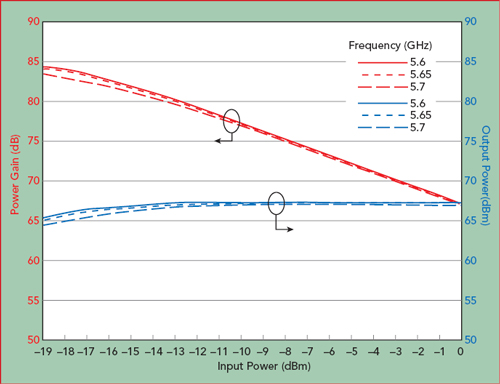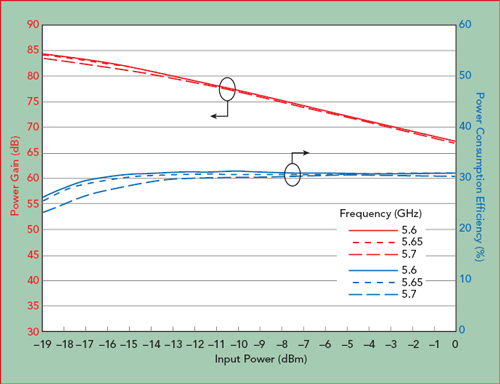RFHIC’s latest 5 kW GaN solid-state transmitter sets new standards for radar systems, offering lower operating cost and precise control. The RRT56575K0-67 operates from 5.6 to 5.7 GHz, combining four GaN power amplifiers (PA) to deliver an unprecedented output power of 5 kW (67 dBm), with harmonic performance better than 40 dBc.
Although most radar systems use magnetrons or other tube-based amplifiers as the core component of the transmitter, such systems are restricted to a low duty cycle, only transmitting 0.2 to 0.3 percent of the time. Solid-state power amplifiers (SSPA), on the other hand, transmit lower power but can operate up to 10 percent duty cycle. This enables approximately 10x higher processing gain and 2x the detection range while using less power and dissipating less heat. The RRT56575K0-67 also provides more control and precision over the RF transmit pulse, creating less spurious emissions.

Figure 1 Output power and power gain vs. input power at 5.6, 5.65 and 5.7 GHz.
The nominal input power range of the RRT56575K0-67 is between −6 dBm and 0 dBm, with a minimum gain of 67 dB at 0 dBm input drive. As the input power decreases, the RRT56575K0-67 increases the gain to maintain the output power close to 67 dBm (5 kW). Output power degradation is minimal unless the input power drops to −19 dBm (see Figure 1). Figure 2 shows the power consumption efficiency and the power gain versus input power. With the input power from approximately −15 to 0 dBm, the power consumption efficiency is 31 percent. The efficiency of the power supply alone is 96 percent.

Figure 2 Power consumption efficiency and power gain vs. input power at 5.6, 5.65 and 5.7 GHz.
COST AND RELIABILITY ADVANTAGES
The RRT56575K0-67 has an outstanding lifetime between 50,000 and 100,000 hours, depending on operating use. The extended lifetime compared to tubes results in significant cost savings. Unlike magnetrons or other tube-based systems using only one power source, the RRT56575K0-67 is configured with four stable and rugged GaN PAs, enabling the transmitter to degrade gracefully should one of the PAs fail. Another cost advantage of a SSPA is the capability to instantly go from unpowered to full power without any warm-up time.
The RRT56575K0-67 has embedded controllers to monitor the operational status of the transmitter. When an abnormal condition such as high temperature or an output mismatch is detected, an alarm controlled by FPGA logic will activate and notify the user. If a critical event occurs, the system automatically shuts down. A DSUB connector in the backplane enables communication to the in-site control station or RFHIC’s dedicated graphical user interface. The physical layer and protocol can be varied to meet system requirements.
MODULAR DESIGN
The RRT56575K0-67 mounts in a standard 19 in. rack and has two main shelves, the transmitter and power supply unit (PSU). The transmitter is 17.78 cm high (4U) and weighs 40 kg, while the PSU is 8.89 cm high (2U) and weighs 20 kg. The transmitter rack can be tailored to integrate the whole system, based upon user needs. The standard circular connector on the amplifier is adapted for AC power input.
Unlike other tube-based transmitters that require costly and complex water-cooling (e.g., chillers), the RRT56575K0-67 was designed to use forced air cooling to dissipate heat, even at high operating temperature. Each of the four GaN PAs is mounted on a heat sink made of an aluminum-based material, and four fans attached to the front panel ventilate hot air within the system. In the case of fan failure, the fan can easily be replaced without interrupting system operation.
The GaN PAs are biased with 50 V, and the RRT56575K0-67’s power supply contains three rectifier modules designed to be load sharing, hot-swappable and n+1 redundant, meaning the SSPA will not stop transmitting RF power if one of the rectifier modules fails. Without taking the transmit system out of service, the failed module can be replaced, just as the microwave amplifier architecture is designed for soft fail redundancy. The PSU takes single phase, AC voltage between 110 and 220 V and produces the bias for the GaN transistors - typically 50 V, although the devices can operate with as high as 53 V bias.
Magnetron and other tube-based systems require high voltage power supplies inside the transmitter shelf, resulting in a dangerous operating environment compared to the RRT56575K0-67, which operates at a much safer voltage.
SOLID ROI
Upgrading to the RRT56575K0-67 will save time and money over the life of the SSPA, making RFHIC’s GaN transmitter a secure and cost-effective investment, well suited to meet the needs of high-power C-Band radar. RFHIC also offers custom GaN PAs, from packaged transistors to custom rack-mount subsystems with up to 50 kW output power.
RFHIC Corp.
Anyang, South Korea
www.rfhic.com/eng/
rfsales@rfhic.com
